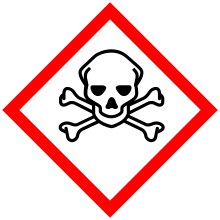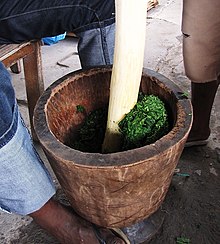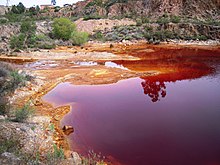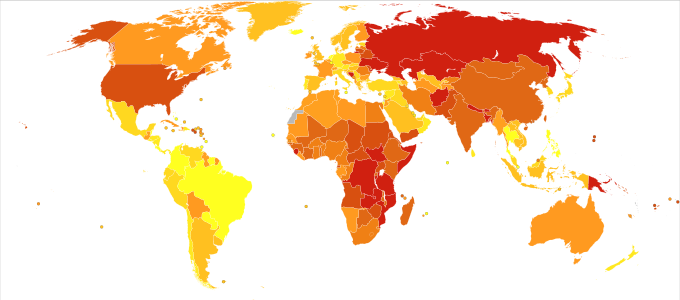Poison
This articlemay need to be rewrittento comply with Wikipedia'squality standards.(January 2022) |

Apoisonis anychemical substancethat is harmful orlethaltoliving organisms.The term is used in a wide range ofscientific fieldsand industries, where it is often specifically defined. It may also be appliedcolloquiallyor figuratively, with a broad sense.
Whether something is considered a poison or not may depend on the amount, the circumstances, and what living things are present.Poisoningcould be accidental or deliberate, and if the cause can be identified there may be ways to neutralise the effects or minimise thesymptoms.
Inbiology,a poison is achemical substancecausingdeath,injury or harm toorganismsor their parts. Inmedicine,poisons are a kind oftoxinthat are delivered passively, not actively. In industry the term may be negative, something to be removed to make a thing safe, or positive, an agent to limit unwantedpests.Inecological terms,poisons introduced into the environment can later cause unwanted effects elsewhere, or in other parts of thefood chain.
Modern definitions
[edit]In broad metaphorical (colloquial) usage of the term, "poison" may refer to anything deemed harmful.
Inbiology,poisons aresubstancesthat can causedeath,injury, or harm toorgans,tissues,cells,andDNAusually by chemical reactions or otheractivityon themolecularscale, when an organism is exposed to a sufficient quantity.[1]
Medicinalfields (particularlyveterinary medicine) andzoologyoften distinguish poisons fromtoxinsandvenoms.Both poisons and venoms are toxins, which aretoxicantsproduced by organisms in nature.[2][3]The difference between venom and poison is the delivery method of the toxin.[2]Venoms are toxins that are actively delivered by being injected via a bite or sting through avenom apparatus,such asfangsor astinger,in a process calledenvenomation,[4]whereas poisons are toxins that are passively delivered by being swallowed, inhaled, or absorbed through the skin.[2]
Uses
[edit]Industry,agriculture,and other sectors employ many poisonous substances, usually for reasons other than theirtoxicityto humans. (e.g. feeding chickens arsenic antihelminths[5][6]),solvents(e.g. rubbing alcohol, turpentine),cleaners(e.g. bleach, ammonia),coatings(e.g. Arsenic wallpaper), and so on. For example, many poisons are importantfeedstocks.The toxicity itself sometimes has economic value, when it serves agricultural purposes ofweed controlandpest control.Most poisonous industrial compounds have associatedmaterial safety data sheetsand are classified ashazardous substances.Hazardous substances are subject to extensive regulation on production, procurement, and use in overlapping domains ofoccupational safety and health,public health,drinking water quality standards,air pollution,andenvironmental protection.Due to the mechanics ofmolecular diffusion,many poisonous compounds rapidly diffuse intobiological tissues,air, water, orsoilon a molecular scale. By the principle ofentropy,chemical contaminationis typically costly or infeasible to reverse, unless specificchelatingagents ormicro-filtrationprocesses are available. Chelating agents are often broader in scope than the acute target, and therefore their ingestion necessitates carefulmedicalorveterinariansupervision.
Pesticidesare one group of substances whose prime purpose is their toxicity to various insects and other animals deemed to be pests (e.g.,ratsandcockroaches). Natural pesticides have been used for this purpose for thousands of years (e.g. concentratedtable saltis toxic to manyslugsandsnails).Bioaccumulationof chemically-prepared agriculturalinsecticidesis a matter of concern for the many species, especiallybirds,whichconsume insectsas a primary food source. Selective toxicity, controlled application, and controlledbiodegradationare major challenges inherbicideand pesticide development and inchemical engineeringgenerally, as all lifeforms on earth share an underlyingbiochemistry;organisms exceptional in their environmental resilience are classified asextremophiles,these for the most part exhibiting radically different susceptibilities.
Ecological lifetime
[edit]A poison which enters thefood chain—whether of industrial, agricultural, ornaturalorigin—might not be immediately toxic to the first organism thatingeststhe toxin, but can become further concentrated inpredatoryorganisms further up the food chain, particularlycarnivoresandomnivores,especially concerningfat solublepoisons which tend to become stored in biological tissue rather than excreted inurineor other water-basedeffluents.
Apart from food, many poisons readily enter the body through theskinandlungs.Hydrofluoric acidis a notorious contact poison, in addition to itscorrosivedamage. Naturally occurringsour gasis a fast-acting atmospheric poison, which can be released byvolcanicactivity ordrilling rigs.Plant-based contact irritants, such as that possessed bypoison ivy,are often classed asallergensrather than poisons; the effect of an allergen being not a poison as such, but to turn the body'snatural defensesagainst itself. Poison can also enter the body through faultymedical implants,or byinjection(which is the basis oflethal injectionin the context ofcapital punishment).
In 2013, 3.3 million cases of unintentional human poisonings occurred.[7]This resulted in 98,000 deaths worldwide, down from 120,000 deaths in 1990.[8]In modern society, cases ofsuspicious deathelicit the attention of theCoroner's office andforensic investigators.
Of increasing concern since the isolation of naturalradiumbyMarieandPierre Curiein 1898—and the subsequent advent ofnuclear physicsand nuclear technologies—areradiological poisons.These are associated withionizing radiation,a mode of toxicity quite distinct from chemically active poisons. Inmammals,chemical poisons are often passed from mother to offspring through theplacentaduring gestation, or throughbreast milkduringnursing.In contrast, radiological damage can be passed from mother or father to offspring through geneticmutation,which—if not fatal inmiscarriageorchildhood,or a direct cause ofinfertility—can then be passed along again to a subsequent generation. Atmosphericradonis a natural radiological poison of increasing impact since humans moved fromhunter-gathererlifestyles andcave dwellingto increasingly enclosed structures able tocontain radonin dangerous concentrations. The 2006poisoning of Alexander Litvinenkowas a notable use of radiological assassination, presumably meant to evade the normal investigation of chemical poisons.
Poisons widely dispersed into the environment are known aspollution.These are often ofhuman origin,but pollution can also include unwanted biological processes such as toxicred tide,or acute changes to the natural chemical environment attributed toinvasive species,which are toxic or detrimental to the prior ecology (especially if the prior ecology was associated with human economic value or an established industry such asshellfishharvesting).
The scientific disciplines ofecologyandenvironmental resource managementstudy the environmental life cycle of toxic compounds and their complex, diffuse, and highly interrelated effects.
Etymology
[edit]The word "poison" was first used in 1200 to mean "a deadly potion or substance"; the English term comes from the "...Old French poison, puison (12c., Modern French poison)" a drink ", especially a medical drink, later" a (magic) potion, poisonous drink "(14c.), from Latin potionem (nominative potio)" a drinking, a drink ", also" poisonous drink "(Cicero), from potare" to drink ".[9]The use of "poison" as an adjective ( "poisonous" ) dates from the 1520s. Using the word "poison" with plant names dates from the 18th century. The term "poison ivy",for example, was first used in 1784 and the term"poison oak"was first used in 1743. The term"poison gas"was first used in 1915.[9]
Terminology
[edit]The term "poison" is often usedcolloquiallyto describe any harmful substance—particularlycorrosivesubstances,carcinogens,mutagens,teratogensand harmfulpollutants,and to exaggerate the dangers of chemicals.Paracelsus(1493–1541), the father oftoxicology,once wrote: "Everything is poison, there is poison in everything.Only the dose makes a thing not a poison"[10] (seemedian lethal dose). The term "poison" is also used in a figurative sense: "His brother's presence poisoned the atmosphere at the party". The law defines "poison" more strictly. Substances not legally required to carry the label "poison" can also cause a medical condition of poisoning.
Some poisons are also toxins, which is any poison produced by an organism, such as thebacterialproteinsthat causetetanusandbotulism.A distinction between the two terms is not always observed, even among scientists. The derivative forms "toxic" and "poisonous" are synonymous. Animal poisons deliveredsubcutaneously(e.g., bystingorbite) are also calledvenom.In normal usage, a poisonous organism is one that is harmful to consume, but a venomous organism uses venom to kill its prey or defend itself while still alive. A single organism can be both poisonous and venomous, but it is rare.[11]
All living things produce substances to protect them from getting eaten, so the term "poison" is usually only used for substances which are poisonous to humans, while substances that mainly are poisonous to a common pathogen to the organism and humans are consideredantibiotics.Bacteria are for example a common adversary forPenicillium chrysogenummold and humans, and since the mold's poison only targets bacteria, humans use it for getting rid of it in their bodies. Humanantimicrobial peptideswhich are toxic to viruses, fungi, bacteria, and cancerous cells are considered a part of the immune system.[12]
Innuclear physics,apoisonis a substance that obstructs or inhibits a nuclear reaction.
Environmentally hazardoussubstances are not necessarily poisons, and vice versa. For example, food-industry wastewater—which may contain potato juice or milk—can be hazardous to the ecosystems of streams and rivers by consuming oxygen and causingeutrophication,but is nonhazardous to humans and not classified as a poison.
Biologically speaking, any substance, if given in large enough amounts, is poisonous and can cause death. For instance,several kilograms worth of water would constitute a lethal dose.Many substances used as medications—such asfentanyl—have anLD50only one order of magnitude greater than theED50.An alternative classification distinguishes between lethal substances that provide a therapeutic value and those that do not.
Poisoning
[edit]
Poisoning can be either acute or chronic, and caused by a variety of natural or synthetic substances. Substances that destroy tissue but do not absorb, such aslye,are classified ascorrosivesrather than poisons.
Acute
[edit]Acute poisoning is exposure to a poison on one occasion or during a short period of time. Symptoms develop in close relation to the exposure. Absorption of a poison is necessary for systemic poisoning. Furthermore, many common household medications are not labeled with skull and crossbones, although they can cause severe illness or even death. Poisoning can be caused by excessive consumption of generally safe substances, as in the case ofwater intoxication.
Agents that act on thenervous systemcan paralyze in seconds or less, and include both biologically derivedneurotoxinsand so-callednerve gases,which may be synthesized forwarfareor industry.
Inhaled or ingestedcyanide,used as a method ofexecutioningas chambers,or as asuicide method,almost instantly starves the body of energy byinhibitingtheenzymesinmitochondriathat makeATP.Intravenous injection of an unnaturally high concentration ofpotassium chloride,such as in the execution of prisoners in parts of the United States, quickly stops theheartby eliminating thecell potentialnecessary formuscle contraction.
Most biocides, includingpesticides,are created to act as acute poisons to target organisms, although acute or less observable chronic poisoning can also occur in non-target organisms (secondary poisoning), including thehumanswho apply the biocides and otherbeneficial organisms.For example, the herbicide2,4-Dimitates the action of a plant hormone, which makes its lethal toxicity specific to plants. Indeed, 2,4-D is not a poison, but classified as "harmful" (EU).
Many substances regarded as poisons are toxic only indirectly, bytoxication.An example is "wood alcohol" ormethanol,which is not poisonous itself, but is chemically converted to toxicformaldehydeandformic acidin theliver.Manydrugmolecules are made toxic in the liver, and the genetic variability of certain liverenzymesmakes the toxicity of many compounds differ between individuals.
Exposure to radioactive substances can produceradiation poisoning,an unrelated phenomenon.
Two common cases of acute natural poisoning aretheobromine poisoningofdogsandcats,andmushroom poisoningin humans. Dogs and cats are not natural herbivores, but a chemical defense developed byTheobroma cacaocan be incidentally fatal nevertheless. Many omnivores, including humans, readily consume ediblefungi,and thus many fungi have evolved to becomedecisively inedible,in this case as a direct defense.
Chronic
[edit]
Chronic poisoning is long-term repeated or continuous exposure to a poison where symptoms do not occur immediately or after each exposure. The person gradually becomes ill, or becomes ill after a long latent period. Chronic poisoning most commonly occurs following exposure to poisons thatbioaccumulate,or arebiomagnified,such asmercury,gadolinium,andlead.
Management
[edit]- Initial management for all poisonings includes ensuring adequatecardiopulmonary functionand providing treatment for any symptoms such asseizures,shock,andpain.
- Injected poisons (e.g., from the sting of animals) can be treated by binding the affected body part with apressure bandageand placing the affected body part in hot water (with a temperature of 50 °C). The pressure bandage prevents the poison being pumped throughout the body, and the hot water breaks it down. This treatment, however, only works with poisons composed of protein-molecules.[13]
- In the majority of poisonings the mainstay of management is providing supportive care for the patient, i.e., treating the symptoms rather than the poison.
Decontamination
[edit]- Treatment of a recently ingested poison may involve gastric decontamination to decrease absorption. Gastric decontamination can involveactivated charcoal,gastric lavage,whole bowel irrigation,ornasogastric aspiration.Routine use of emetics (syrup of Ipecac),catharticsor laxatives are no longer recommended.
- Activated charcoalis the treatment of choice to prevent poison absorption. It is usually administered when the patient is in the emergency room or by a trained emergency healthcare provider such as a Paramedic or EMT. However, charcoal is ineffective againstmetalssuch assodium,potassium,andlithium,andalcoholsandglycols;it is also not recommended for ingestion of corrosive chemicals such asacidsandalkalis.[14]
- Catharticswere postulated to decrease absorption by increasing the expulsion of the poison from thegastrointestinal tract.There are two types of cathartics used in poisoned patients; saline cathartics (sodium sulfate,magnesium citrate,magnesium sulfate) and saccharide cathartics (sorbitol). They do not appear to improve patient outcome and are no longer recommended.[15]
- Emesis(i.e. induced byipecac) is no longer recommended in poisoning situations, because vomiting is ineffective at removing poisons.[16]
- Gastric lavage,commonly known as a stomach pump, is the insertion of a tube into the stomach, followed by administration of water or saline down the tube. The liquid is then removed along with the contents of the stomach. Lavage has been used for many years as a common treatment for poisoned patients. However, a recent review of the procedure in poisonings suggests no benefit.[17]It is still sometimes used if it can be performed within 1 hour of ingestion and the exposure is potentially life-threatening.
- Nasogastric aspirationinvolves the placement of a tube via the nose down into the stomach, the stomach contents are then removed by suction. This procedure is mainly used for liquid ingestions where activated charcoal is ineffective, e.g.ethylene glycol poisoning.
- Whole bowel irrigationcleanses the bowel. This is achieved by giving the patient large amounts of apolyethylene glycolsolution. The osmotically balanced polyethylene glycol solution is not absorbed into the body, having the effect of flushing out the entiregastrointestinal tract.Its major uses are to treat ingestion of sustained release drugs, toxins not absorbed by activated charcoal (e.g.,lithium,iron), and for removal of ingested drug packets (body packing/smuggling).[18]
Enhanced excretion
[edit]- In some situations elimination of the poison can be enhanced usingdiuresis,hemodialysis,hemoperfusion,hyperbaric medicine,peritoneal dialysis,exchange transfusionorchelation.However, this may actually worsen the poisoning in some cases, so it should always be verified based on what substances are involved.
Epidemiology
[edit]In 2010, poisoning resulted in about 180,000 deaths down from 200,000 in 1990.[19]There were approximately 727,500 emergency department visits in the United States involving poisonings—3.3% of all injury-related encounters.[20]
Applications
[edit]Poisonous compounds may be useful either for their toxicity, or, more often, because of another chemical property, such as specific chemical reactivity. Poisons are widely used in industry and agriculture, as chemical reagents, solvents or comple xing reagents, e.g.carbon monoxide,methanolandsodium cyanide,respectively. They are less common in household use, with occasional exceptions such asammoniaandmethanol.For instance,phosgeneis a highly reactivenucleophileacceptor, which makes it an excellent reagent for polymerizingdiolsanddiaminesto producepolycarbonateandpolyurethaneplastics. For this use, millions of tons are produced annually. However, the same reactivity makes it also highly reactive towards proteins in human tissue and thus highly toxic. In fact, phosgene has been used as achemical weapon.It can be contrasted withmustard gas,which has only been produced for chemical weapons uses, as it has no particular industrial use.
Biocides need not be poisonous to humans, because they can target metabolic pathways absent in humans, leaving only incidental toxicity. For instance, the herbicide2,4-dichlorophenoxyacetic acidis a mimic of a plant growth hormone, which causes uncontrollable growth leading to the death of the plant. Humans and animals, lacking this hormone and its receptor, are unaffected by this, and need to ingest relatively large doses before any toxicity appears. Human toxicity is, however, hard to avoid with pesticides targeting mammals, such asrodenticides.
The risk from toxicity is also distinct from toxicity itself. For instance, the preservativethiomersalused in vaccines is toxic, but the quantity administered in a single shot is negligible.
-
Deaths from poisonings per million persons in 20120-23-56-78-1011-1213-1920-2728-4142-5556-336
-
Disability-adjusted life yearfor poisonings per 100,000 inhabitants in 2004.[21]no data<1010–9090–170170–250250–330330–410410–490490–570570–650650–700700–880>880
History
[edit]
Throughout human history, intentional application of poison has been used as a method ofmurder,pest-control,suicide,andexecution.[22][23]As a method of execution, poison has been ingested, as the ancient Athenians did (seeSocrates), inhaled, as withcarbon monoxideorhydrogen cyanide(seegas chamber), injected (seelethal injection), or even as anenema.[24]Poison's lethal effect can be combined with its allegedlymagicalpowers; an example is theChinesegupoison.Poison was also employed ingunpowder warfare.For example, the 14th-century Chinese text of theHuolongjingwritten byJiao Yuoutlined the use of a poisonous gunpowder mixture to fillcast irongrenadebombs.[25]
Whilearsenicis a naturally occurring environmental poison, its artificial concentrate was once nicknamedinheritance powder.[26]InMedievalEurope, it was common formonarchsto employ personalfood tastersto thwart royalassassination,in the dawning age of theApothecary.
Figurative use
[edit]The termpoisonis also used in a figurative sense. The slang sense of alcoholic drink is first attested 1805, American English (e.g., a bartender might ask a customer "what's your poison?" or "Pick your poison" ).[9] Figurative use of the term dates from the late 15th century.[27]Figuratively referring to persons as poison dates from 1910.[27]The figurative term poison-pen letter became well known in 1913 by a notorious criminal case in Pennsylvania, U.S.; the phrase dates to 1898.
See also
[edit]- Agency for Toxic Substances and Disease Registry(ATSDR) – US federal agency
- Antidote– Substance that can counteract a form of poisoning
- Biosecurity– Preventive measures designed to reduce the risk of infectious disease transmission
- Contaminated haemophilia blood products– Health crisis in the late 1970s up to 1985
- Food taster– Person ingesting food prepared for someone else to ensure it's safe to eat
- Infection– Invasion of an organism's body by pathogenic agents
- EPA list of extremely hazardous substances
- Lists of poisonings
- List of poisonous plants
- List of types of poison
- Mr. Yuk– Label that indicates poisonous material
- Poison ring– Ring with concealed compartment which could be used to store poison
- Saxitoxin– Paralytic shellfish toxin
- Toxics use reduction– Approach to pollution prevention
- Toxic waste– Any unwanted material which can cause harm
References
[edit]- ^"Poison"atMerriam-Webster.Retrieved December 26th, 2014.
- ^abc"Poison vs. Venom".Australian Academy of Science.3 November 2017.Retrieved17 April2022.
- ^Chippaux, JP; Goyffon, M (2006). "[Venomous and poisonous animals--I. Overview]".Médecine Tropicale(in French).66(3): 215–20.ISSN0025-682X.PMID16924809.
- ^Gupta, Ramesh C., ed. (24 March 2017).Reproductive and developmental toxicology.Saint Louis: Elsevier Science. pp. 963–972.ISBN978-0-12-804240-3.OCLC980850276.
- ^Hunt, Chris (13 May 2013)."The Arsenic in Your Chicken".Huffington Post.
- ^"Did the FDA Admit That 70% of U.S. Chickens Contain Arsenic?".Snopes. 20 Jan 2015.
- ^Global Burden of Disease Study 2013 collaborators (22 August 2015)."Global, regional, and national incidence, prevalence, and years lived with disability for 301 acute and chronic diseases and injuries in 188 countries, 1990-2013: a systematic analysis for the Global Burden of Disease Study 2013".Lancet.386(9995): 743–800.doi:10.1016/s0140-6736(15)60692-4.PMC4561509.PMID26063472.
- ^GBD 2013 Mortality and Causes of Death collaborators (17 December 2014)."Global, regional, and national age-sex specific all-cause and cause-specific mortality for 240 causes of death, 1990-2013: a systematic analysis for the Global Burden of Disease Study 2013".Lancet.385(9963): 117–71.doi:10.1016/S0140-6736(14)61682-2.PMC4340604.PMID25530442.
- ^abc"poison - Search Online Etymology Dictionary".etymonline.Retrieved3 November2017.
- ^ Latin:Dosis sola venenum facit.Paracelsus:Von der Besucht,Dillingen, 1567
- ^Hutchinson DA, Mori A, Savitzky AH, Burghardt GM, Wu X, Meinwald J, Schroeder FC (2007)."Dietary sequestration of defensive steroids in nuchal glands of the Asian snake Rhabdophis tigrinus".Proceedings of the National Academy of Sciences of the United States of America.104(7): 2265–70.Bibcode:2007PNAS..104.2265H.doi:10.1073/pnas.0610785104.PMC1892995.PMID17284596.
- ^Reddy KV, Yedery RD, Aranha C (2004). "Antimicrobial peptides: premises and promises".International Journal of Antimicrobial Agents.24(6): 536–547.doi:10.1016/j.ijantimicag.2004.09.005.PMID15555874.
- ^Complete diving manual by Jack Jackson
- ^Chyka PA, Seger D, Krenzelok EP, Vale JA (2005). "Position paper: Single-dose activated charcoal".Clin Toxicol.43(2): 61–87.doi:10.1081/CLT-51867.PMID15822758.S2CID218856921.
- ^Toxicology, American Academy of Clinical (2004). "Position paper: cathartics".J Toxicol Clin Toxicol.42(3): 243–253.doi:10.1081/CLT-120039801.PMID15362590.S2CID46629852.
- ^American Academy of Clinical Toxicology; European Association of Poisons Centres Clinical Toxicologists (2004). "Position paper: Ipecac syrup".J Toxicol Clin Toxicol.42(2): 133–143.doi:10.1081/CLT-120037421.PMID15214617.S2CID218865551.
- ^Vale JA, Kulig K (2004). "Position paper: gastric lavage".J Toxicol Clin Toxicol.42(7): 933–43.doi:10.1081/clt-200045006.PMID15641639.S2CID29957973.
- ^"Position paper: whole bowel irrigation".J Toxicol Clin Toxicol.42(6): 843–854. 2004.doi:10.1081/CLT-200035932.PMID15533024.S2CID800595.
- ^Lozano, R (Dec 15, 2012)."Global and regional mortality from 235 causes of death for 20 age groups in 1990 and 2010: a systematic analysis for the Global Burden of Disease Study 2010".Lancet.380(9859): 2095–128.doi:10.1016/S0140-6736(12)61728-0.hdl:10536/DRO/DU:30050819.PMC10790329.PMID23245604.S2CID1541253.
- ^Villaveces A, Mutter R, Owens PL, Barrett ML.Causes of Injuries Treated in the Emergency Department, 2010.HCUP Statistical Brief #156. Agency for Healthcare Research and Quality. May 2013.[1]Archived2017-01-20 at theWayback Machine
- ^"WHO Disease and injury country estimates".World Health Organization.2004.RetrievedNov 11,2009.
- ^Kautilyasuggests employing means such as seduction, secret use of weapons, poison etc. S.D. Chamola,Kautilya Arthshastra and the Science of Management: Relevance for the Contemporary Society,p. 40.ISBN81-7871-126-5.
- ^Kautilya urged detailed precautions against assassination—tasters for food, elaborate ways to detect poison.Boesche Roger (2002). "Moderate Machiavelli? ContrastingThe Princewith theArthashastraof Kautilya ".Critical Horizons: A Journal of Philosophy.3(2): 253–276.doi:10.1163/156851602760586671.S2CID153703219..
- ^Julius Friedenwald and Samuel Morrison (January 1940). "The History of the Enema with Some Notes on Related Procedures (Part I)".Bulletin of the History of Medicine.8(1): 113.JSTOR44442727.
- ^Needham, Joseph (1986).Science and Civilization in China: Volume 5, Part 7.Taipei: Caves Books, Ltd. Page 180.
- ^Yap, Amber (14 November 2013)."Arsenic The" Inheritance Powder. "".prezi.Prezi.Retrieved19 March2018.
- ^ab"Online Etymology Dictionary".etymonline.Archived fromthe originalon 5 December 2015.Retrieved3 November2017.
External links
[edit]- National Capital Poison Center
- webPOISONCONTROL(R)
- Agency for Toxic Substances and Disease Registry
- American Association of Poison Control Centers
- American College of Medical Toxicology
- Clinical Toxicology Teaching WikiArchived2009-04-22 at theWayback Machine
- Find Your Local Poison Control Centre Here (Worldwide)
- Poison Prevention and Education Website
- Cochrane Injuries GroupArchived2020-08-03 at theWayback Machine,Systematic reviews on the prevention, treatment and rehabilitation of traumatic injury (including poisoning)
- Pick Your Poison—12 Toxic Talesby Cathy Newman


![Disability-adjusted life year for poisonings per 100,000 inhabitants in 2004.[21] no data <10 10–90 90–170 170–250 250–330 330–410 410–490 490–570 570–650 650–700 700–880 >880](https://upload.wikimedia.org/wikipedia/commons/thumb/3/36/Poisonings_world_map_-_DALY_-_WHO2004.svg/680px-Poisonings_world_map_-_DALY_-_WHO2004.svg.png)